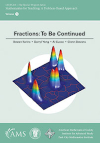- About MAA
- Membership
- MAA Publications
- Periodicals
- Blogs
- MAA Book Series
- MAA Press (an imprint of the AMS)
- MAA Notes
- MAA Reviews
- Mathematical Communication
- Information for Libraries
- Author Resources
- Advertise with MAA
- Meetings
- Competitions
- Programs
- Communities
- MAA Sections
- SIGMAA
- MAA Connect
- Students
- MAA Awards
- Awards Booklets
- Writing Awards
- Teaching Awards
- Service Awards
- Research Awards
- Lecture Awards
- Putnam Competition Individual and Team Winners
- D. E. Shaw Group AMC 8 Awards & Certificates
- Maryam Mirzakhani AMC 10 A Awards & Certificates
- Two Sigma AMC 10 B Awards & Certificates
- Jane Street AMC 12 A Awards & Certificates
- Akamai AMC 12 B Awards & Certificates
- High School Teachers
- News
You are here
Fractions: To Be Continued

Buy Now:
Publisher:
AMS
Publication Date:
2022
Number of Pages:
126
Format:
Paperback
Series:
IAS/PCMI - The Teacher Program Series
Price:
50.00
ISBN:
978-1-4704-6293-2
Category:
Problem Book
[Reviewed by , on ]
Mary Beth Rollick
04/10/2022
This book presents the program of the Park City Math Institute during the summer 2018 which ran for two hours a day for three weeks. The focus that year was on Harmonic Analysis and the problems highlight connections with continuing fractions, the Euclidean algorithm, golden ratio, Pell equations, approximations of rational and irrational numbers as well as many other topics. Because the book is written so that the reader discovers relationships, it would be best used for workshops and seminars where each problem set is solved consecutively. Each problem set will take at least two hours to enjoy.
Fractions: To Be Continued provides an opportunity to discover the beauty of mathematics. The book consists of 14 problem sets and each set begins with Opener Problems followed by Important Stuff. These are problems which must be solved to achieve the basic goals of the Park City Math Institute program on Harmonic Analysis. Each problem set also contains Neat Stuff and Tough Stuff which are problems to challenge anyone. Because of this arrangement of problems, high school students can experience success and enthusiastically see connections while doing the Important stuff problems. One example of a math topic discovery is seeing the relationship between GCD and continuing fractions. While less experienced students will concentrate on the Important Stuff, teachers and professors can find satisfaction in doing Neat Stuff and Tough Stuff.
This book is arranged so that Chapter 1 contains all 14 problem sets. In the margins of the problem sets are pertinent and humorous comments which motivate and/or amuse. Chapter 2 presents Facilitator Notes. These notes explain the goals of the problem set and include prompts for helping students. The notes also identify the important problems for whole group discussion to ensure understanding for all. Chapter 3 gives answers to many of the problems. The book does not have an index - you truly learn by doing.
Although all the goals of the Harmonic Analysis program require that all 14 problem sets be completed, topic endpoints occur along the way with Problem Set 4 and Set 9. Participants investigate patterns, use reasoning, test and formalize mathematics conjectures, and apply theories to solve problems. Essentially participants “think deeply about simple things”. The struggle with new ideas and connections makes for satisfying discovery.
As I began doing the problems for this review, I did not expect to be captivated by the excitement of seeing so many connections and it propelled me to complete this review in record time. I highly recommend this book for workshops and seminars for teachers in high school and in college.
Mary Beth Rollick is Professor Emerita at Kent State University, in Kent, Ohio. She enjoys tutoring students to help them find the joy of mathematics as well as to understand the “why” and the “how” of mathematics.
See the publisher's website.
- Log in to post comments




